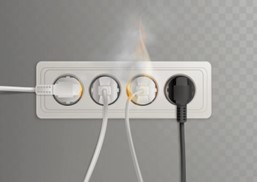What To Do (And Not To) In An Electrical Emergency?
 While most risks can be mitigated by taking appropriate precautions and adhering to established procedures, the unexpected can occur. If you are involved in an electrical emergency, you must know what to do.
While most risks can be mitigated by taking appropriate precautions and adhering to established procedures, the unexpected can occur. If you are involved in an electrical emergency, you must know what to do.
There are generally four types of electrical emergencies.
- Power Outage
- Electric Fire
- Electric Shock
- Fallen Power Lines
This article includes everything you need to do in each case, so you can stay safe and get it fixed to prevent any long-term or even fatal damage.
Pause & Reflect
If one of your family or co-workers has suffered a severe electric shock, your first instinct will most likely be to rush to their aid.
However, you must pause and reflect. As the human body is an excellent conductor of electricity, the charge that is just carried through your family member or co-worker could easily move onto you if you come into contact with them. Provided that electricity has the potential to kill or severely harm, your top priority needs to be to limit the number of people who are subjected to the shock, and thus you must protect yourself as well by minimizing contact and wearing insulated apparel.
Victims of severe electric shocks will require medical attention, so call an ambulance before attempting to handle anything else.
Be Cautious of Spilled Water
Be cautious if water has been spilled on the site. Water attracts electrons, so practice caution when moving around the area until the power is switched off. If you are alone, it is critical that you contact emergency services as quickly as possible.
Disconnect Everything
If it is safe to do so without endangering yourself, turn the power off. This will allow you to move around the scene more safely when the ambulance arrives, preventing further damage. In situations where power cannot be safely disconnected, use a dry, non-conductive object such as a wooden broomstick to disconnect the victim from the power source, or use a low-voltage rescue kit if it is readily available.
First-Aid Measures
You can approach the victim and start first aid only if the victim is away from the current. Electric shock injuries can range from severe burns to cardiac arrest and death, and you need to know how to handle different scenarios.
- If there is a burn reaction: Treat the injury by soaking the burn in cold water for more than ten minutes and then cover it with a bandage. If you do not have a first aid kit, kitchen wrap will do, as long as it’s not too tight. Do not apply oil or ointment to the burn.
- If the patient is not breathing: Provide cardiopulmonary resuscitation (CPR) to a non-breathing, unconscious victim until the medical team arrives for treatment.
Ending Note
To ensure electrical safety in your home, cover all electrical outlets with surge protectors. Also, have safety switches installed by a professional electrician to monitor the flow of electricity so that you can prevent any mishaps in the future.
